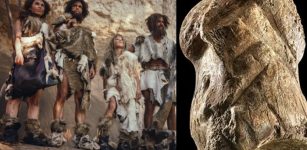Florida’s Windover Bog Bodies Predate The Egyptian Pyramids And Can Rewrite Ancient American History
Jan Bartek - AncientPages.com - There is a fascinating ancient underwater cemetery in Florida, North America. It is called Windover Pond, and it is 8,000 years old. Windover Pond is older than the Great Pyramids of Egypt and can help unravel the mystery of ancient Americans.
The human remains discovered in the Windover Pond can rewrite America's ancient history.
Large image: The Windover site. Credit: Seven Ages - Middle image: illustration of one of the bog bodies found at the site. Credit: Brevard Museum of History and Natural Science
Windover Pond, east of Orlando, Florida, was discovered by chance in 1982. When archaeologists investigated the submerged burial place, they found several well—preserved artifacts and numerous individuals buried in the peat at the bottom of the pond. Today, known as the Windover bog bodies, these remains are a perplexing archaeological mystery.
This site is exceptionally unique in North America for several reasons. For one thing, the age of Windover Pond makes it an important archaeological and historical site. It is also rare to find underwater burials where artifacts and human bodies have been excellently preserved. From a scientific point of view, the most significant part of this site is discovering many bog bodies. As many as 168 bog bodies were found in Windover Pont, allowing scientists to study a large sample of DNA.
Who Were The People Buried In The Underwater Windover Cemetery?
There are many bog bodies in European peats, but they are less well-preserved than the Windover bog bodies. There must have been some elements in the Windover sinkhole that helped protect the brain tissues for thousands of years.
One of the most significant elements of the Windover site was the discovery of the oldest complexly woven cloth made of plant fiber in the Americas. Pieces of 7,000 to 8,000-year-old fabric were found with human burials at the Windover Archaeological Site in Florida. Since the burials were in a peat pond. The fabric had turned into peat but was still identifiable. Credit: Brevard Museum of History and Natural Science
Scientists suggest "that the slight acidity and high mineral content of the water in the sinkhole might contribute to their longevity. The preservation of brain tissues is reflected by preservation of ancient DNA, and the Windover sinkhole has yielded one of North America's large ancient genetic populations." 1
Scientists were surprised to see the results when they started to examine the Windover bog bodies. Windover Pond has "yielded dozens of extraordinary well-preserved brains with analyzable DNA. William Hauswirth of the University of Florida College of Medicine identified two mtDNA variants in the Windover material that he had not seen before." 2
Human remains recovered from the remarkable underwater cemetery created by ancient people about 8,000 years ago. Credit: Image compilation AncientPages.com
Some years ago, Andrew Merriwether, a geneticist at the University of Michigan, did one of the most extensive surveys of mtDNA sequences from modern and ancient Native Americans.
Hauswirth contacted Merriwether and asked him to look at the DNA results.
Hauswirth learned that Merriwether had identified the same variants. Named X6 and X7, these variants "had been found in several modern and South American Indian populations. Their presence remains as early as those from Windover, indicating that they were likely among the variants that came to the New World in the original migration." 2
When Hauswirth extended his DNA study, "one particular element caught his attention.
At one specific locus, all except one of the individuals shared one allele in common. It would not merit comment in many a less variable region, but in this volatile part of the genome, it did suggest a blood connection between the individuals.
Hauswirth and his colleagues focused on one gene on the first human chromosome. Hauswirth explored this possibility by looking at some other highly variable regions. Like many interested in recovering ancient kin patterns, he turned to microsatellites.
Scientists examining the Windover Pond underwater cemetery. Credit: MyFloridaHistory.org
This gene contained one of those microsatellites that Hagelberg had exploited, made up of tandem repeats of the cytosine-adenine couplet. According to genetic lineage, there may be fewer than ten or more than twenty couplets in the microsatellite.
Among the Windover individuals, however, two particular microsatellite lengths dominate the population, one of nine repeats and the other of fifteen repeats. Alongside the HLA evidence, this was a further indication of close blood ties within a population placing its dead in the pond over several centuries." 1
The fact that these people were related explains why they buried their dead in the Windover Pond.
The assumption about people who lived 8,000 years ago is that they were too nomadic to develop much of a culture and couldn't afford to care for disabled people. Still, the Windover bog bodies tell a different story.
Among the skeletons found in the Windover sinkhole, archaeologists found remains "of a boy crippled from spina bifida who had to be carried around and treated for the 16 years of his life. And there was an elderly woman who also needed such long-term care. Our ancient ancestors apparently tended carefully to each other despite their constant need to keep themselves safe and alive." 3
What is still unknown is where these people came from, and some theories exist. The DNA studies indicate these people were of Asian origin, similar to the four other significant haplotypes of Native American peoples.
Merriwether explained that genetic evidence does not tell when these people arrived.
The historical and archaeological significance of Windover Pond should be considered. This site has provided "unprecedented and dramatic" information about early Archaic people in Florida and could be one of the most significant archaeological sites ever excavated in North America. 4
Written by Jan Bartek - AncientPages.com Staff Writer
Updated on Oct 1, 2023
Copyright © AncientPages.com All rights reserved. This material may not be published, broadcast, rewritten or redistributed in whole or part without the express written permission of AncientPages.com
Expand for references- Martin Jones - Unlocking the Past: How Archaeologists Are Rewriting Human History with Ancient DNA
- Powledge, Tabitha M., and Mark Rose. "The Great DNA Hunt Part II: Colonizing The Americas." Archaeology 49, no. 6 (1996)
- Ellen Lloyd - Windover Pond – Remarkable 8,000-Year-Old Underwater Cemetery In North America, AncientPages.com
- Milanich, Jerald T. "Recent Archaeological Research In Florida." Archaeology of Eastern North America 23 (1995): 97-118.
More From Ancient Pages
-
 Tarkhan Dress – The World’s Oldest Woven Garment
Archaeology | Feb 24, 2016
Tarkhan Dress – The World’s Oldest Woven Garment
Archaeology | Feb 24, 2016 -
 Viking Cemetery In Lutomiersk And DNA May Solve The Mystery Of Norse Warriors In Central Poland
Vikings | Jan 7, 2025
Viking Cemetery In Lutomiersk And DNA May Solve The Mystery Of Norse Warriors In Central Poland
Vikings | Jan 7, 2025 -
 Facial Reconstruction Of Ancient Inhabitants Of Sagalassos Make Them Almost Real
Archaeology | May 31, 2019
Facial Reconstruction Of Ancient Inhabitants Of Sagalassos Make Them Almost Real
Archaeology | May 31, 2019 -
 51,000-Year-Old Bone Carving Shows Neanderthals Were Artistic Long Before Humans Arrived
Archaeology | Jul 6, 2021
51,000-Year-Old Bone Carving Shows Neanderthals Were Artistic Long Before Humans Arrived
Archaeology | Jul 6, 2021 -
 Image Of The Day: The Inghirami Tomb At Volterra, Italy
Image Of The Day | Sep 9, 2015
Image Of The Day: The Inghirami Tomb At Volterra, Italy
Image Of The Day | Sep 9, 2015 -
 Fascinating Legend Of The Seven Sleepers Of Ephesus
Featured Stories | Oct 31, 2016
Fascinating Legend Of The Seven Sleepers Of Ephesus
Featured Stories | Oct 31, 2016 -
 Ancient Mosaics Dated To The First Century Discovered In Southern Turkey
Archaeology | Jan 14, 2019
Ancient Mosaics Dated To The First Century Discovered In Southern Turkey
Archaeology | Jan 14, 2019 -
 Royal Colossi Fragments, Mud Brick Wall And Pottery Uncovered In Matariya, Egypt
Archaeology | Dec 4, 2019
Royal Colossi Fragments, Mud Brick Wall And Pottery Uncovered In Matariya, Egypt
Archaeology | Dec 4, 2019 -
 Stolen Antique Tamil Nadu Statues Have Been Returned By Britain To India
Artifacts | Sep 23, 2020
Stolen Antique Tamil Nadu Statues Have Been Returned By Britain To India
Artifacts | Sep 23, 2020 -
 Remains Of Colonnaded Hall Of 26th Dynasty Found At Ancient Buto Temple, Northern Nile Delta
Archaeology | Nov 18, 2022
Remains Of Colonnaded Hall Of 26th Dynasty Found At Ancient Buto Temple, Northern Nile Delta
Archaeology | Nov 18, 2022 -
 Extremely Rare 700-Year-Old French Gothic Ivory Casket At Risk Of Leaving The UK
Archaeology | Dec 7, 2022
Extremely Rare 700-Year-Old French Gothic Ivory Casket At Risk Of Leaving The UK
Archaeology | Dec 7, 2022 -
 New Species Of Stegosaur Is Oldest Discovered In Asia, And Possibly The World
Fossils | Mar 7, 2022
New Species Of Stegosaur Is Oldest Discovered In Asia, And Possibly The World
Fossils | Mar 7, 2022 -
 ‘Impossible’ Advanced Ancient Technology In Mesopotamia – Evidence Of Other-Worldly Interaction?
Featured Stories | May 24, 2021
‘Impossible’ Advanced Ancient Technology In Mesopotamia – Evidence Of Other-Worldly Interaction?
Featured Stories | May 24, 2021 -
 Algonquin People And The Myth Of The Medicine Woman In The Moon
Featured Stories | Feb 1, 2016
Algonquin People And The Myth Of The Medicine Woman In The Moon
Featured Stories | Feb 1, 2016 -
 Why Is The Yarm Viking Helmet Special?
Archaeology | Aug 10, 2020
Why Is The Yarm Viking Helmet Special?
Archaeology | Aug 10, 2020 -
 Hiawatha And The Legendary Great Peacemaker – Native American Heroes Who Founded The League Of The Iroquois
Featured Stories | Feb 25, 2019
Hiawatha And The Legendary Great Peacemaker – Native American Heroes Who Founded The League Of The Iroquois
Featured Stories | Feb 25, 2019 -
 Thousands Want To Drink Red Liquid From The Granite Sarcophagus In Egypt
Archaeology | Jul 23, 2018
Thousands Want To Drink Red Liquid From The Granite Sarcophagus In Egypt
Archaeology | Jul 23, 2018 -
 Gunung Padang – Remarkable Megalithic Site In Indonesia
Civilizations | Jun 14, 2014
Gunung Padang – Remarkable Megalithic Site In Indonesia
Civilizations | Jun 14, 2014 -
 Spectacular 2,500 Years Old Shwedagon Pagoda In Myanmar – World’s Oldest Pagoda
Featured Stories | Oct 18, 2018
Spectacular 2,500 Years Old Shwedagon Pagoda In Myanmar – World’s Oldest Pagoda
Featured Stories | Oct 18, 2018 -
 Temple Dedicated To Goddess Nemesis Discovered Under Ancient Theater In Greece
Archaeology | May 20, 2019
Temple Dedicated To Goddess Nemesis Discovered Under Ancient Theater In Greece
Archaeology | May 20, 2019




